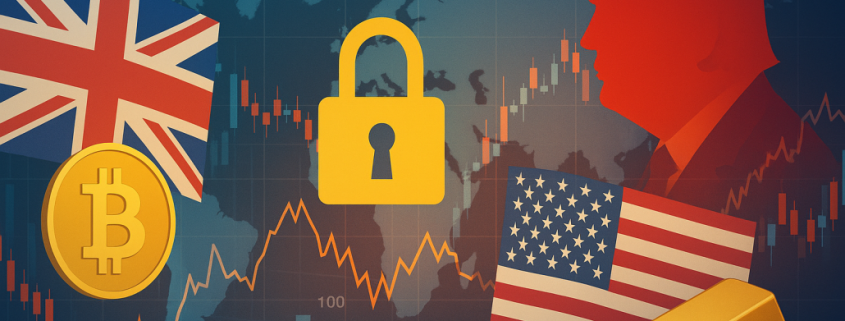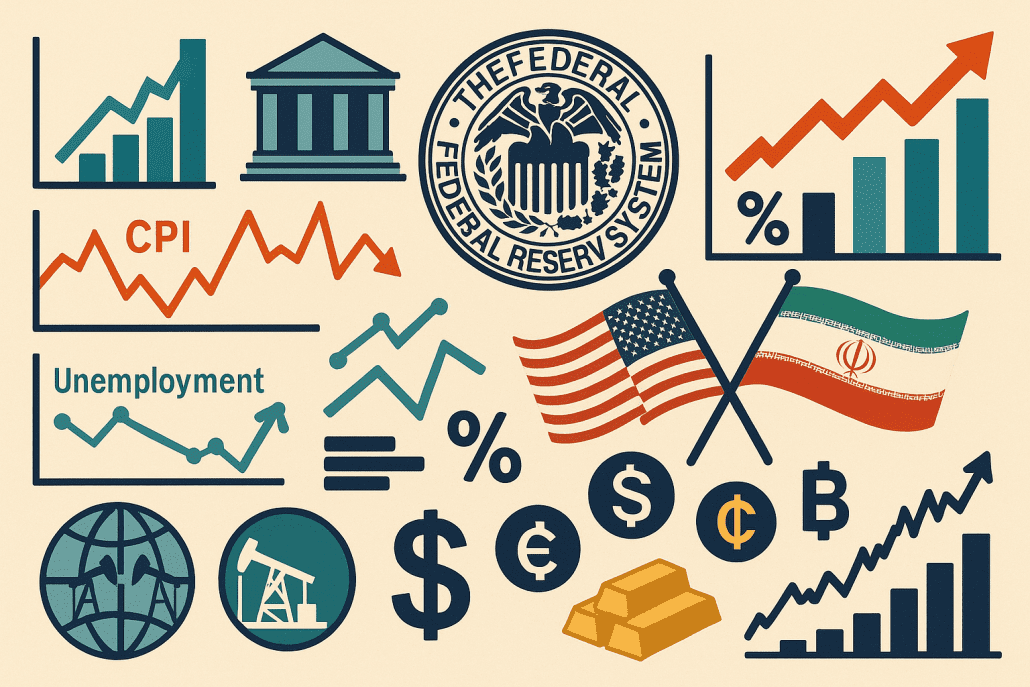Monthly Market Wrap (May 2025)
Join our Telegram channel for more market analysis & trading tips: t.me/synapsetrading
Table of Contents
Macroeconomic Data and Central Bank Signals
Inflation data showed divergent trends across the globe. In the UK, inflation unexpectedly surged to 3.5% year-on-year in April, a significant jump from March’s 2.6% and the highest level since early 2024. This increase was driven in part by higher travel costs during the Easter period. The surprise figure reduced expectations for an August interest rate cut from the Bank of England, with market odds falling from 60% to 40%, indicating a potentially slower pace of monetary easing.
In contrast, inflation in the U.S. continued to ease. April’s Consumer Price Index rose just 2.3% year-on-year, its lowest level since February 2021, slightly below expectations. Core inflation also moderated to 2.8%, edging closer to the Federal Reserve’s 2% target. This cooling of price pressures has strengthened the belief among many analysts that the Fed is likely finished with rate hikes for now, although officials have not suggested any imminent rate cuts.
Elsewhere, global data presented a mixed economic picture. Japan’s economy shrank by an annualized 0.7% in the first quarter, worse than expected, marking its first contraction in a year. This decline was attributed to weak consumer spending and sluggish exports, even before factoring in the impact of recent U.S. trade measures. Analysts warn that Japan remains especially vulnerable to external shocks such as tariffs from the U.S., complicating the Bank of Japan’s policy path.
In China, April’s data was uneven. Industrial production rose 6.1%, beating expectations, largely due to government support. However, retail sales growth lagged at 5.1%, falling short of forecasts. Export demand also remains under pressure from ongoing U.S. tariffs. Additionally, weak lending figures and persistent deflationary trends point to a need for further stimulus. Mid-May brought a surprise development when Beijing and Washington agreed to roll back most tariffs and pause their trade dispute for 90 days. While this truce offered short-term relief and boosted exports, economists remain cautious, citing the unpredictability of U.S. trade policy.
Political and Policy Developments Impacting Markets
Geopolitical and fiscal developments drove much of this week’s market volatility. In the U.S., concerns over government spending took center stage as lawmakers advanced a large tax and spending package expected to significantly increase the federal deficit. In response, Moody’s downgraded U.S. government debt by one notch, citing persistent and unsustainable fiscal imbalances.
The downgrade jolted bond markets. The yield on the 10-year Treasury note spiked to 4.60% midweek, its highest level since February, before retreating slightly to around 4.5% by the week’s end. An underwhelming 20-year Treasury auction further spooked markets, reinforcing fears of rising borrowing costs amid fiscal slippage. Meanwhile, a looming standoff over the federal debt ceiling added further uncertainty, with the Treasury Department warning that extraordinary funding measures could be exhausted by August.
Later in the week, global trade tensions flared again. Former President Donald Trump reignited fears of a trade war by announcing plans to impose a sweeping 50% tariff on all goods imported from the European Union, effective June 1. The proposed tariff would target a wide array of European products, from luxury goods to pharmaceuticals. Trump also threatened to impose a 25% import tariff on iPhones assembled overseas and sold in the U.S., targeting Apple directly.
These announcements came just after a temporary de-escalation in U.S.–China trade tensions and caught both investors and EU officials by surprise. European leaders hinted at potential retaliation, raising the risk of an escalating global trade conflict. Some analysts described Trump’s strategy as one that could undo recent market gains and reignite instability in global commerce. The tariff threat has left businesses scrambling to assess the implications for supply chains and consumer prices. Walmart’s CEO warned that these taxes would likely lead to higher retail prices, as companies couldn’t absorb the cost increases. Trump dismissed those concerns, suggesting companies should bear the brunt instead of passing it on to consumers. This policy U-turn, from easing tensions with China to confronting Europe, left global markets on edge.
U.S. Stock Market Highlights and Corporate Earnings
After a strong showing earlier in May, U.S. equities stumbled this week due to a mix of disappointing earnings reports and renewed macro concerns. Both the S&P 500 and Dow Jones Industrial Average dropped more than 2% for the week, breaking a three-week winning streak. A steep decline on Friday dragged both indices back into negative territory for the year.
Market volatility surged, with the VIX (commonly referred to as the market’s “fear gauge”) jumping 10% to reach its highest level in over two weeks. Investor sentiment turned cautious, prompting a rotation out of high-growth sectors. Technology, communication services, and consumer discretionary stocks led the pullback, while defensive sectors such as utilities and consumer staples posted modest gains.
Apple’s stock dropped around 3% following Trump’s iPhone tariff threat, marking a two-week low. The sell-off extended across other major tech names: Tesla fell nearly 3%, Nvidia dropped 2%, and Microsoft, Amazon, and Meta also lost ground. Alphabet (Google), however, managed a 3% mid-week gain thanks to renewed optimism about its AI initiatives. Nonetheless, the broader tech retreat ended a strong run for the Nasdaq, which had posted gains in six of the previous seven sessions.
Earnings reports presented a mixed bag, particularly in the retail space. Walmart posted better-than-expected earnings, with an adjusted EPS of $0.61, and reaffirmed its full-year outlook. However, its warnings about higher prices due to tariffs led to a 4% decline in its stock price. Target delivered disappointing results. Sales fell 2.8% in Q1, and it cut its full-year sales forecast to a low single-digit decline, citing weaker consumer spending and concern over tariffs. The stock fell more than 5% in response.
There were a few bright spots. Home Depot exceeded revenue expectations and maintained its profit forecast, supported by steady demand for home improvement. Executives said they would try not to raise prices despite the tariff pressures, although they cautioned that some low-margin imported items might be removed from shelves. Lowe’s also beat earnings expectations and reaffirmed its outlook, helping to minimize losses in its stock price.
In the tech sector, Nvidia and other AI-related stocks had been market leaders earlier in the month, with Nvidia’s stock climbing ahead of earnings on expectations of a 60% year-over-year revenue surge. However, these gains reversed later in the week amid broader risk-off sentiment. Chipmakers and cloud companies that had seen strong rallies experienced some profit-taking.
Other notable moves included Deckers Outdoor, which fell nearly 20% after it withdrew full-year guidance and warned of weaker sales due to tariff uncertainty. Meanwhile, Palo Alto Networks beat expectations but still saw its stock fall by about 7%, likely due to lofty investor expectations. UnitedHealth shares rose 8% on Monday after a sharp drop the previous week due to leadership changes and a DOJ probe. But by mid-week, the stock fell another 6% on renewed allegations of misconduct. These fluctuations highlight how sensitive markets remain to company-specific developments in the current environment. As earnings season winds down, broader macro drivers like trade policy and interest rates are returning to the forefront of investor focus.
Global Market Developments: Europe, Asia, and Commodities
U.S. policy decisions reverberated through global financial markets. European equities broke a six-week winning streak as Trump’s EU tariff threats roiled sentiment. The pan-European STOXX 600 index fell 0.9% on Friday, with the Eurozone’s blue-chip index down 1.5%. Germany’s DAX, which had recently approached record highs, was hit particularly hard. The UK’s FTSE 100 fared slightly better, supported by its newly signed trade agreement with the U.S., which offered protection from the looming tariffs.
European automakers, luxury brands, and technology exporters saw notable stock declines amid worries about lost access to U.S. markets. Bond yields in the region, which had risen earlier in the week following the UK’s inflation surprise, retreated later in the week as investors moved into safe havens.
In Asia, market performance was mixed. Chinese indices such as the Shanghai Composite and CSI300 posted modest moves as investors weighed weaker-than-expected retail sales and an ailing property sector against the hope of new policy support. Japan’s Nikkei index pulled back from recent highs after the disappointing GDP report and as the yen strengthened, dampening prospects for exporters.
Emerging markets also experienced turbulence mid-week when U.S. yields spiked, though conditions stabilized as yields eased later on.
Commodities reflected a tension between easing inflation and slowing growth. Oil prices remained subdued, with U.S. crude trading in the mid-$60s per barrel. Optimism about strong summer demand was tempered by concerns over China’s soft economic data and the risk of further trade conflicts. China’s April figures showed a drop in both oil refining and steel output, suggesting weakening demand. Industrial metals like copper and iron ore followed suit, slipping from recent highs amid fears the global manufacturing rebound could stall.
Precious metals, on the other hand, surged. Gold climbed past $3,200 per ounce, setting a new all-time high as investors flocked to safe-haven assets. The metal has posted double-digit gains this year, bolstered by a weaker dollar and global uncertainty.
In the cryptocurrency space, Bitcoin broke through the $100,000 mark and reached an all-time high near $110,000 mid-week, fueled by growing institutional interest and a supportive regulatory environment. However, the gains were volatile. Bitcoin fell sharply after hitting $109,900 but later rebounded. The movement also triggered rallies in related stocks, underscoring the asset class’s rising mainstream acceptance alongside its speculative nature.
Conclusion
In the past month, markets have faced a mix of constructive economic data and destabilizing policy shifts. U.S. inflation continued to trend lower, helping ease pressure on the Fed and boosting market optimism early in the week. Corporate earnings, especially in retail and tech, were mixed but generally solid enough to support equity markets.
However, by the end of the month, sentiment had turned more cautious. A shock uptick in UK inflation raised fresh concerns about global price stability, while a sudden reescalation in trade rhetoric from the U.S., this time targeting Europe, revived fears of a broader slowdown. These developments sent U.S. stocks and global indices lower, with bond markets swinging in response to a U.S. credit downgrade and safe-haven flows.
Amid these headwinds, gold surged and cryptocurrencies hit new highs, reflecting a defensive shift in investor positioning. In short, markets are navigating a fragile balance. While inflation is cooling and growth is holding up, policy volatility, whether fiscal or geopolitical, has the potential to shake confidence quickly. All eyes now turn to whether the latest round of trade tensions will escalate or be contained, as the answer will significantly influence global market direction heading into June.
 Our flagship mentoring program is suitable for both beginners and advanced traders, covering the 4 strategies which I used over the past 15 years to build up my 7-figure personal trading portfolio.
Our flagship mentoring program is suitable for both beginners and advanced traders, covering the 4 strategies which I used over the past 15 years to build up my 7-figure personal trading portfolio.
 If you're looking for a reputable brokerage that covers all products (SG stocks, US stocks, global stocks, bonds, ETFs, REITs, forex, futures, crypto) and has one of the lowest commissions, this is what I currently use.
If you're looking for a reputable brokerage that covers all products (SG stocks, US stocks, global stocks, bonds, ETFs, REITs, forex, futures, crypto) and has one of the lowest commissions, this is what I currently use.
After trading for 18 years, reading 1500+ books, and mentoring 1000+ traders, I specialise in helping people improve their trading results, by using tested trading strategies, and making better decisions via decision science.






Leave a Reply
Want to join the discussion?Feel free to contribute!